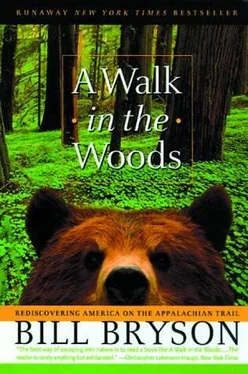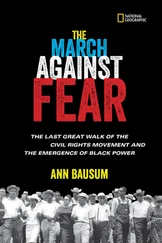Bill Bryson - A Walk In The Woods
Здесь есть возможность читать онлайн «Bill Bryson - A Walk In The Woods» весь текст электронной книги совершенно бесплатно (целиком полную версию без сокращений). В некоторых случаях можно слушать аудио, скачать через торрент в формате fb2 и присутствует краткое содержание. Жанр: Современная проза, на английском языке. Описание произведения, (предисловие) а так же отзывы посетителей доступны на портале библиотеки ЛибКат.
- Название:A Walk In The Woods
- Автор:
- Жанр:
- Год:неизвестен
- ISBN:нет данных
- Рейтинг книги:4 / 5. Голосов: 1
-
Избранное:Добавить в избранное
- Отзывы:
-
Ваша оценка:
- 80
- 1
- 2
- 3
- 4
- 5
A Walk In The Woods: краткое содержание, описание и аннотация
Предлагаем к чтению аннотацию, описание, краткое содержание или предисловие (зависит от того, что написал сам автор книги «A Walk In The Woods»). Если вы не нашли необходимую информацию о книге — напишите в комментариях, мы постараемся отыскать её.
A Walk In The Woods — читать онлайн бесплатно полную книгу (весь текст) целиком
Ниже представлен текст книги, разбитый по страницам. Система сохранения места последней прочитанной страницы, позволяет с удобством читать онлайн бесплатно книгу «A Walk In The Woods», без необходимости каждый раз заново искать на чём Вы остановились. Поставьте закладку, и сможете в любой момент перейти на страницу, на которой закончили чтение.
Интервал:
Закладка:
Altogether, 122 people have lost their lives on Washington. Until recently, when it was overtaken by Mount Denali in Alaska, it was the most murderous mountain in North America. So when the fearless Dr. Abdu and I pulled up at its base a few days later for the second of our grand ascents, I had brought enough backup clothes to cross the Arctic-waterproofs, woollen sweater, jacket, gloves, spare trousers, and long underwear. Never again would I be chilled at height.
Washington, the highest peak north of the Smokies and east of the Rockies at a solidly respectable 6,288 feet, gets few clear days, and this was a clear day, so the crowds were out in force. I counted over seventy cars at the Pinkham Notch Visitor Center lot at 8:10 in the morning when we arrived, and more pouring in every minute. Mount Washington is the most popular summit in the White Mountains, and the Tuckerman Ravine Trail, our chosen route, is the most popular trail up. Some 60,000 hikers a year take to the Tuckerman route, though a good many of them get a lift to the top of the mountain and walk down, so the figures are perhaps a trifle skewed. In any case, it was no more than moderately busy on a good, hot, blue-skied, gorgeously promising morning in late July.
The walk up was much easier than I had dared hope. Even now, I could not quite get used to the novelty of walking big hills without a large pack. It makes such a difference. I won’t say we bounded up, but considering that we had almost 4,500 feet of climb in a little over three miles, we walked at a pretty steady clip. It took us two hours and forty minutes (Bill’s hiking guide to the White Mountains suggested a walking time of four hours and fifteen minutes), so we were pretty proud.
There may be more demanding and exciting summits to reach along the Appalachian Trail than Mount Washington but none can be more startling. You labor up the last steep stretch of rocky slope to what is after all a considerable eminence and pop your head over the edge, and there you are greeted by, of all things, a vast, terraced parking lot, full of automobiles gleaming hotly in the sun. Beyond stands a scattered complex of buildings among which move crowds of people in shorts and baseball caps. It has the air of a world’s fair bizarrely transferred to a mountaintop. You get so used along the AT to sharing summits with only a few other people, all of whom have worked as hard as you to get there, that this was positively dazzling. On Washington, visitors can arrive by car on a winding toll road or on a cog railway from the other side, and hundreds of people-hundreds and hundeds of them, it seemed-had availed themselves of these options. They were everywhere, basking in the sunshine, draped over the railings on the viewing terraces, wandering between various shops and food places. I felt for some minutes like a visitor from another planet. I loved it. It was a nightmare, of course, and a desecration of the highest mountain in the northeast, but I was delighted it existed in one place. It made the rest of the trail seem perfect.
The epicenter of activity was a monstrously ugly concrete building, the Summit Information Center, with big windows, broad viewing platforms, and an exceedingly lively cafeteria. Just inside the door was a large list of all the people who had died on the mountain and the causes, beginning with one Frederick Strickland of Bridlington, Yorkshire, who lost his way while hiking in an October storm in 1849, and ran on through a quite breathtaking array of mishaps before concluding with the deaths of two hikers in an avalanche just three months earlier. Already six people had died on Washington’s slopes in 1996, with the year barely half over-quite a sobering statistic-and there was plenty of room on the board for more.
In the basement was a small museum with displays on Washington’s climate, geology, and distinctive plant life, but what particularly captivated me was a comical short video called “Breakfast of champions,” which I presume the meteorologists had made for their own amusement. It was filmed with a fixed camera on one of the summit terraces and showed a man sitting at a table, as if at an open-air restaurant, during one of its famous blows. While the man holds down the table with his arms, a waiter approaches against the wind with great and obvious difficulty, like someone wingwalking at 30,000 feet. He tries to pour the customer a bowl of cereal, and it all flies horizontally from the box. Then he adds milk, but this goes the same way (mostly over the customer-a particularly gratifying moment). Then the bowl flies away and the silverware, as I recall, and then the table starts to go, and then the film ends. It was so good I watched it twice, then went off to find Bill so he could see it. I couldn’t spot him in the restless throngs, so I went outside on to the viewing platform and watched the cog railway train chuffing up the mountain, pouring out clouds of black smoke as it went. It stopped at the summit station and hundreds of more happy tourists tumbled off.
Tourism goes back a long way on Mount Washington. As early as 1852 there was a restaurant at the summit and the proprietors were serving about a hundred meals a day. In 1853, a small stone hotel called Tip-Top House was built atop the mountain and was a huge and immediate success. Then in 1869 a local entrepreneur named Sylvester March built the cog railway, the first in the world. Everyone thought he was mad and that even if he succeeded in building the railway, which was doubtful, there wouldn’t be any demand for it. In fact, as the disgorging throngs below me demonstrated now, people haven’t tired of it yet.
Five years after the railway opened the old Tip-Top was succeeded by a much grander Summit House Hotel, and that was followed by a forty-foot-tower with a multicolored searchlight, which could be seen all over New England and far out to sea. By late in the century a daily newspaper was being published on the summit as a summer novelty and American Express had opened a branch office.
Meanwhile back at ground level, things were also booming. The modern tourist industry, in the sense of people traveling en masse to a congenial spot and finding lots of diversions awaiting them when they got there, is essentially a White Mountains invention. Massive hotels, with up to 250 rooms, sprang up in every glen. Built in a jaunty domestic style, like cottages blown up to the scale of hospitals or sanitoria, these were exceedingly ornate and elaborate structures, among the largest and most complicated ever built of wood, with wandering rooflines robustly punctuated with towers and turrets and every other mark of architectural busyness the Victorian mind could devise. They had winter gardens and salons, dining rooms that could seat 200, and porches like the promenade decks of ocean liners from which guests could drink in the wholesome air and survey nature’s craggy splendor.
The finer hotels were very fine indeed. The Profile House at Franconia Notch had its own private railway line to Bethlehem Junction eight miles away; its grounds held twenty-one cottages, each with up to twelve bedrooms. The Maplewood had its own casino. Guests at the Crawford House could choose among nine daily newspapers from New York and Boston, shipped in specially. Whatever was new and exciting-elevators, gas lighting, swimming pools, golf courses-the White Mountain hotels were in the vanguard. By the 1890s, there were 200 hotels scattered through the White Mountains. There has never been a collection of hotels of comparable grandeur anywhere, certainly not in a mountain setting. Now, however, they are virtually all gone.
In 1902, the grandest of them all, the Mount Washington Hotel, opened at Bretton Woods, in an open, meadowy setting against the backdrop of the Presidential Range. Built in a commanding style described optimistically by the architect as “Spanish Renaissance,” it was the pinnacle of grace and opulence, with 2,600 acres of cultivated grounds, 235 guest rooms, and every detail of finery that heaps of money could buy. For the plasterwork alone, the developers brought in 250 Italian artisans. But already it was something of an anachronism.
Читать дальшеИнтервал:
Закладка:
Похожие книги на «A Walk In The Woods»
Представляем Вашему вниманию похожие книги на «A Walk In The Woods» списком для выбора. Мы отобрали схожую по названию и смыслу литературу в надежде предоставить читателям больше вариантов отыскать новые, интересные, ещё непрочитанные произведения.
Обсуждение, отзывы о книге «A Walk In The Woods» и просто собственные мнения читателей. Оставьте ваши комментарии, напишите, что Вы думаете о произведении, его смысле или главных героях. Укажите что конкретно понравилось, а что нет, и почему Вы так считаете.












